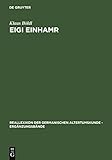Eigi Einhamr : Beiträge zum Weltbild der Eyrbyggja und anderer Isländersagas / Klaus Böldl.
Material type: TextSeries: Ergänzungsbände zum Reallexikon der Germanischen Altertumskunde ; 48Publisher: Berlin ; Boston : De Gruyter, [2012]Copyright date: ©2005Description: 1 online resource (306 p.)Content type:
TextSeries: Ergänzungsbände zum Reallexikon der Germanischen Altertumskunde ; 48Publisher: Berlin ; Boston : De Gruyter, [2012]Copyright date: ©2005Description: 1 online resource (306 p.)Content type: - 9783110185829
- 9783110926323
- online - DeGruyter
- Issued also in print.
| Item type | Current library | Call number | URL | Status | Notes | Barcode | |
|---|---|---|---|---|---|---|---|
 eBook
eBook
|
Biblioteca "Angelicum" Pont. Univ. S.Tommaso d'Aquino Nuvola online | online - DeGruyter (Browse shelf(Opens below)) | Online access | Not for loan (Accesso limitato) | Accesso per gli utenti autorizzati / Access for authorized users | (dgr)9783110926323 |
Habilitation Universität München 2004.
i-iv -- Vorwort -- Inhaltsverzeichnis -- 1. Einleitung: »The structure of the saga remains an enigma«: Elemente einer literaturwissenschaftlichen Rezeptionsgeschichte -- 2. Die Welt im Text: Anthropologische und historische Perspektiven auf die Sagaliteratur -- 3. Das Weltbild der Eyrbyggja saga – einige anthropologische Kategorien -- 4. Die Landnahmezeit in der Eyrbyggja saga und in anderen hochmittelalterlichen Quellen -- 5. Opfer und ritualisierte Tötungsakte in der Eyrbyggja saga und anderen norrönen Überlieferungen -- 6. Schluß -- Bibliographie
restricted access online access with authorization star
http://purl.org/coar/access_right/c_16ec
Die im 13. Jahrhundert entstandene Eyrbyggja saga gehört zu den wichtigsten, aufgrund ihrer scheinbar heterogenen, chronikartig angeordneten Handlungselemente aber auch meistdiskutierten Isländersagas. Ausgehend von der zentralen Bedeutung, die der Gott Thor in seiner Funktion als Stifter und Bewahrer der Kultur für die Siedlergemeinschaft erfüllt, zeichnet Böldl die Vorstellungen nach, die sich für die mittelalterlichen Isländer mit der Etablierung eines geordneten Gemeinwesens verbinden. Thematische Schwerpunkte hierbei bilden die Landnahme sowie der komplexe Opferdiskurs der Saga.
The 13th century Eyrbyggja saga is one of the most important Icelandic sagas, but also one of the most discussed because of the seemingly heterogeneous elements of its plot, which unfolds it as a chronicle. The present study takes as its starting point the central significance of the god Thor in his function as the founder and preserver of culture for the community of settlers, and attempts to develop the ideas connected with the establishment of an ordered community life for the medieval Icelanders. The thematic foci are provided by the occupation and settlement of land and the complex discourse of sacrifice in the saga.
Issued also in print.
Mode of access: Internet via World Wide Web.
In German.
Description based on online resource; title from PDF title page (publisher's Web site, viewed 28. Feb 2023)


